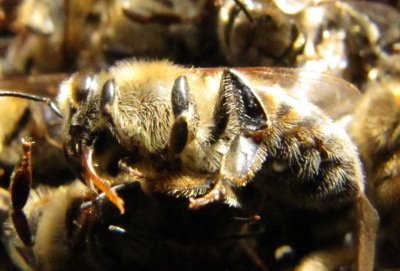
How to autopsy a bee hive
 Did
you know that around 38% of U.S. bee hives die each year, a number that has more than tripled in the last decade? Most of those deaths aren't from colony
collapse disorder, though, and many can be prevented.
Did
you know that around 38% of U.S. bee hives die each year, a number that has more than tripled in the last decade? Most of those deaths aren't from colony
collapse disorder, though, and many can be prevented.
One of the most valuable
parts of Natural Beekeeping is
information on conducting a hive autopsy. I've excerpted the four
most interesting/likely causes of bee death below, but you'll want to
check the book if you've got conditions that don't fit those listed
here.
- Colony Collapse Disorder is implicated if there are few or no adult bees on the combs or bottom boards --- the bees have just disappeared. There should be capped brood and honey present, and the latter will usually be untouched be robber bees.
- Varroa mites have killed your hive if you see lots of bees with deformed wings and short abdomens and lots of varroa mites on the dead bees, brood, and bottom board. Also look for tiny holes in brood cappings.
- Starvation signs include bees with their heads tucked into comb in search of absent honey and a lack of honey within two inches of the remains of the cluster.
- Pesticide or chemical poisoning results in dead bees in front of the hive with their tongues sticking out.
Knowing the cause of
death will help you decide whether you can reuse
the equipment (yes, unless your bees died of one of the contagious
diseases not mentioned here) and how you can prevent the same fate
befalling your other hives. So dry your tears and poke through
the rubble to become a better beekeeper.
| This post is part of our Natural Beekeeping lunchtime series.
Read all of the entries: |
Want more in-depth information? Browse through our books.
Or explore more posts by date or by subject.
About us: Anna Hess and Mark Hamilton spent over a decade living self-sufficiently in the mountains of Virginia before moving north to start over from scratch in the foothills of Ohio. They've experimented with permaculture, no-till gardening, trailersteading, home-based microbusinesses and much more, writing about their adventures in both blogs and books.
Want to be notified when new comments are posted on this page? Click on the RSS button after you add a comment to subscribe to the comment feed, or simply check the box beside "email replies to me" while writing your comment.

Both hives are dead. Most of the dead bees were littered across the bottom board and the front of the slatted base board. They had the diminutive abdomens that are indicative of a varroa infestation, but none of the deformed wings and there were not a great many of the actual mites to be found among them; although certainly some. The brood box contained no brood except a tiny patch that had probably been capped back in autumn, some uncapped honey and a few frames that were mostly pollen.
The top box, a shallow, was where I discovered the last of the cluster reduced to about the size of a tennis ball, smack dab in the middle of the remaining stores of honey, about 3 large combs full. The queen was not among them, and I got the impression that she'd been absent from the hive for quite some time.
My diagnosis, as inexpert as it is: The colony was hived too late (early April?) after the onset of the nectar flow. They did not build up as quickly as they probably should've. Except for a couple late season sugar frostings (They're GRRRRRRRRRREAT!), I left this Russian strain to their own devices regarding varroa. But I think there were enoguh to greatly weaken the colony and reduced its numbers to the point that they were unable to generate enough heat to keep the large space inside the average 10 frame Lang warm enough.
No more Langstroth hives for me. I've got this last upcoming season to practice before I give up on keeping honeybees and I'm going to use the Kenyan top bar (and a warre, if I can get one built by April) to the exclusion of all others and I bet the farm my fortune turns on this one factor - style of hive.
1: My first bit of confusion is how can a site with this much good intent and diverse info not have a reader comment since 2011 2: I Have 2 hives and was present for 2 swarms within 3 weeks in same hive late summer 2012. Re-queened mid August but it was late in season and they did not make it thru winter. The second hive was buzzing in January 2013 when I knocked on it and I even got stung during that quick same day peek so figured all was well but that hive also did not make it thru winter. When autopsied second hive noticed very few bees, small abdomens, small drones, some mite carcass on bottom board but nothing outstanding. Confusing. I think with so few bees must have had a swarm when I was not around. So many lost hives in upstate NY that I may not be able to get a package this late. 3: About the 2 swarms I was present for, it was an amazing experience to stand in awe in those clouds unable to anything except say goodbye. They both settled 60 feet up in a super tight fir tree and getting them seemed impossible. 4: Getting ready to extract left over honey and freeze 4 frames to introduce 2 packages, fingers crossed. Still unsure what I am looking at on the frames as there are so many different things going on. Good luck to all of you.